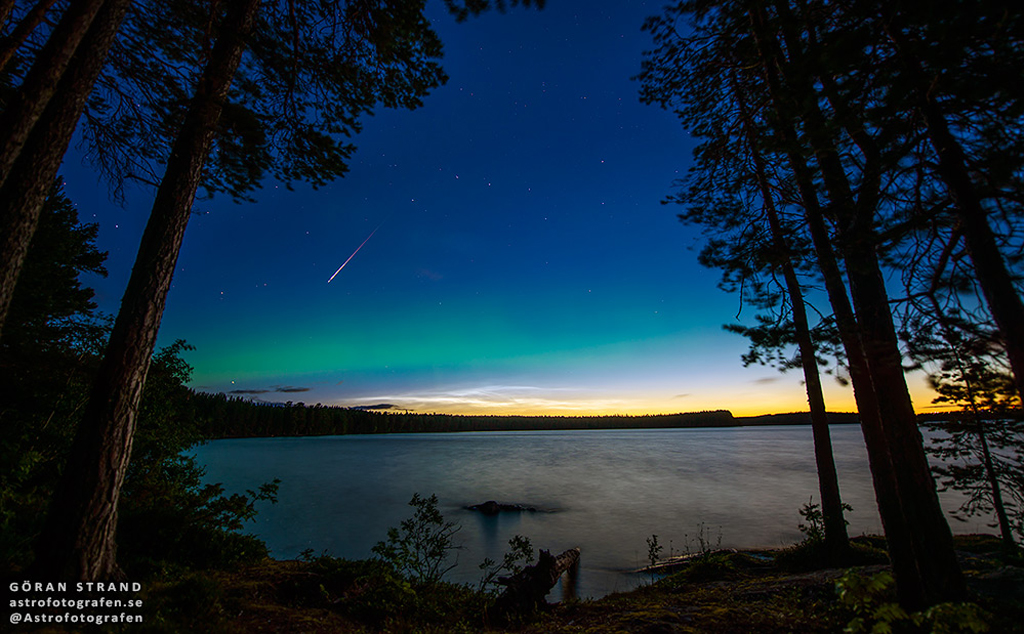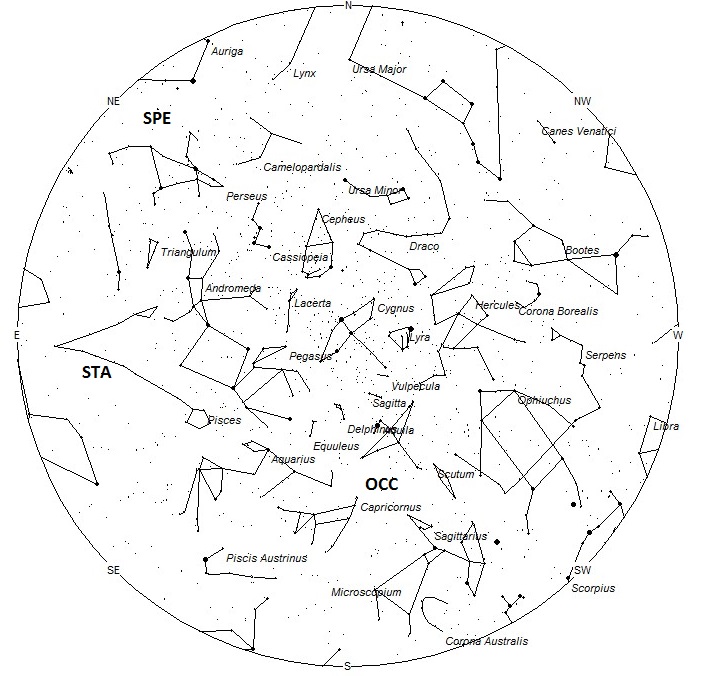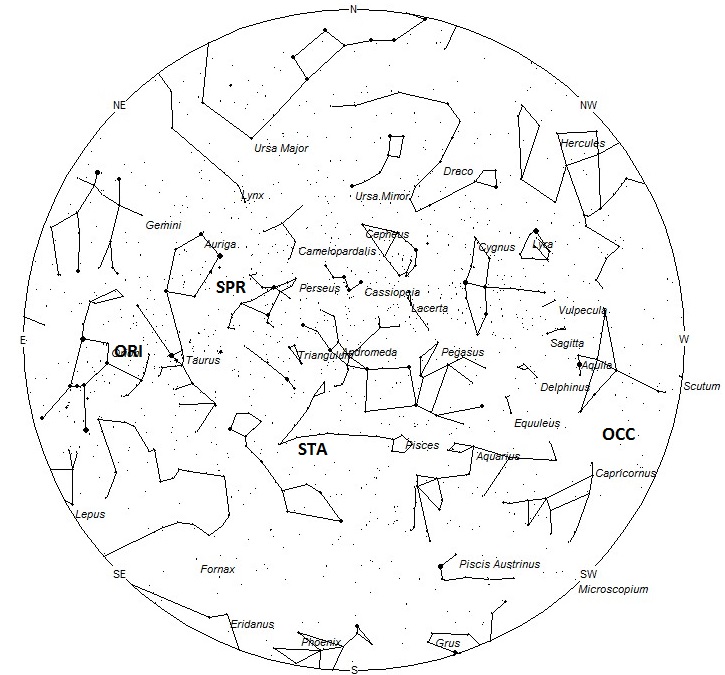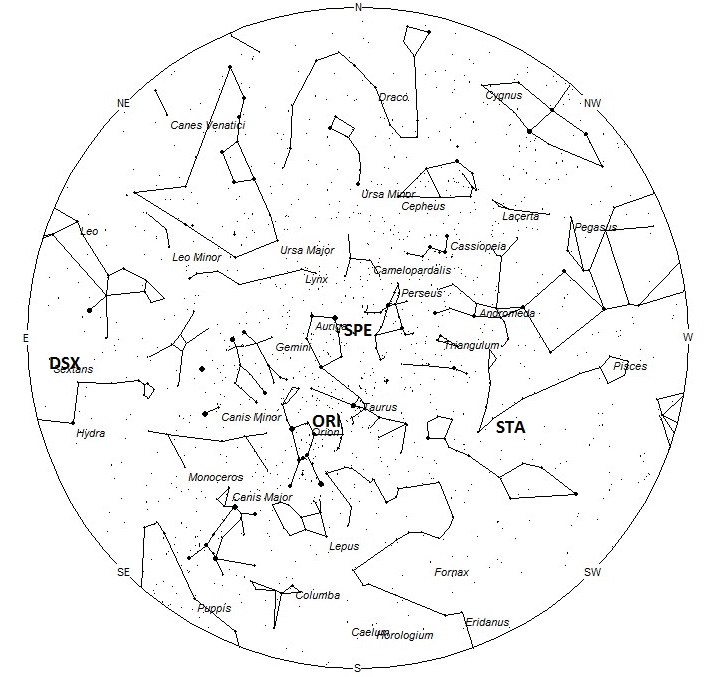
During this period the moon wanes from nearly half illuminated down to only a few percent by the end of the week. This weekend the waning crescent moon will rise during the early morning hours and will cause interference with viewing meteor activity. This can be overcome by observing areas of the sky free of lunar glare. By the end of the week the moon will not be a factor as it becomes slender and rises just before dawn. The estimated total hourly meteor rates for evening observers this week is near 4 as seen from mid-northern latitudes (45N) and 3 as seen from tropical southern locations (25S). For morning observers the estimated total hourly rates should be near 12 as seen from mid-northern latitudes (45N) and 10 as seen from tropical southern locations (25S). Rates during this period are slightly reduced during the morning hours due to moonlight. The actual rates will also depend on factors such as personal light and motion perception, local weather conditions, alertness and experience in watching meteor activity. Note that the hourly rates listed below are estimates as viewed from dark sky sites away from urban light sources. Observers viewing from urban areas will see less activity as only the brightest meteors will be visible from such locations.
The radiant (the area of the sky where meteors appear to shoot from) positions and rates listed below are exact for Saturday night/Sunday morning September 24/25 These positions do not change greatly day to day so the listed coordinates may be used during this entire period. Most star atlases (available at science stores and planetariums) will provide maps with grid lines of the celestial coordinates so that you may find out exactly where these positions are located in the sky. A planisphere or computer planetarium program is also useful in showing the sky at any time of night on any date of the year. Activity from each radiant is best seen when it is positioned highest in the sky, either due north or south along the meridian, depending on your latitude. It must be remembered that meteor activity is rarely seen at the radiant position. Rather they shoot outwards from the radiant so it is best to center your field of view so that the radiant lies at the edge and not the center. Viewing there will allow you to easily trace the path of each meteor back to the radiant (if it is a shower member) or in another direction if it is a sporadic. Meteor activity is not seen from radiants that are located below the horizon. The positions below are listed in a west to east manner in order of right ascension (celestial longitude). The positions listed first are located further west therefore are accessible earlier in the night while those listed further down the list rise later in the night.
These sources of meteoric activity are expected to be active this week.
Experienced observers are urged to be on the lookout for any activity from the October Capricornids (OCC). These meteors are possibly related to lost comet D/1978 R1 (Haneda-Campos). If the comet still exists it would reach perihelion in November 2016. A moderate display of bright meteors was seen from Australia on October 3, 1972. Other attempts at observing these meteors were less successful. With a favorable lack of moonlight in the evening sky during this period, observers are urged to monitor for any very slow meteors radiating from the border of Capricornus and Aquila near the position 20:06 (302) -09. This position is roughly 5 degrees northwest of the naked eye double star known as Algedi (alpha2 Capricorni). While the possible maximum is a week away, members of this stream may be visible this week from a position slightly west at 19:44 (296) -10. This position is best placed near 2000 (8pm) when the radiant lies highest above the horizon. While this area of the sky is fairly well placed for northern observers, it is much more favorably placed for those south of the equator where it lies much higher in the sky. Like the Daytime Sextantids mentioned below, any observations of these stream (either positive or negative) would be important to our understanding of these streams.
The Southern Taurids (STA) are active from a large radiant centered near 01:20 (020) +06. This position lies in southeastern Pisces, 4 degrees southeast of the 4th magnitude star known as epsilon Piscium. These meteors may be seen all night long but the radiant is best placed near 0200 local daylight time (LDT) when it lies on the meridian and is located highest in the sky. Rates at this time should be near 2 per hour regardless of your location. With an entry velocity of 29 km/sec., the average Southern Taurid meteor would be of slow velocity.
The September Epsilon Perseids (SPE) are active from the 5th through the 28th with the peak occurring on the night of September 8/9. The radiant is currently located at 04:32 (068) +42. This position lies in eastern Perseus, between the bright stars Capella (alpha Aurigae) and epsilon Persei. The radiant is best placed near 0500 LDT, when it lies highest above the horizon. Rates are expected to be less than 1 per hour no matter your location. With an entry velocity of 65 km/sec., most activity from this radiant would be swift.
The Orionids (ORI) are active from a radiant located at 05:16 (079) +09, which places it in northwestern Orion, 4 degrees northwest of the 2nd magnitude star known as Bellatrix (gamma Orionis). This area of the sky is best placed in the sky during the last hour before dawn, when it lies highest above the horizon in a dark sky. Current rates would be near 2 per hour no matter your location. With an entry velocity of 67 km/sec., most activity from this radiant would be of swift speed.
The Daytime Sextantids (DSX) are not well known due to the fact that the radiant lies close to the sun and these meteors are only visible during the last couple of hours before dawn. The radiant is located at 10:00 (150) 00. This position lies in western Sextans, just west of the 4th magnitude star known as alpha Sextantis. This position is also 12 degrees south of the 1st magnitude star known as Regulus (alpha Leonis). This area of the sky is best placed in the sky during the last hour before dawn, when it lies highest above the horizon in a dark sky. Current rates would be most likely less than 1 per hour no matter your location. Spotting any of this activity would be a notable accomplishment. With an entry velocity of 33km/sec., most activity from this radiant would be of medium-slow speed.
As seen from the mid-northern hemisphere (45N) one would expect to see approximately 8 sporadic meteors per hour during the last hour before dawn as seen from rural observing sites. Evening rates would be near 3 per hour. As seen from the tropical southern latitudes (25S), morning rates would be near 6 per hour as seen from rural observing sites and 2 per hour during the evening hours. Locations between these two extremes would see activity between the listed figures. Morning rates are slightly reduced during this period due to moonlight.
The table below presents a list of radiants that are expected to be active this week. Rates and positions are exact for Saturday night/Sunday morning except where noted in the shower descriptions.
| SHOWER | DATE OF MAXIMUM ACTIVITY | CELESTIAL POSITION | ENTRY VELOCITY | CULMINATION | HOURLY RATE | CLASS |
| RA (RA in Deg.) DEC | Km/Sec | Local Daylight Saving Time | North-South | |||
| October Capricornids (OCC) | Oct 02 | 19:44 (296) -10 | 15 | 20:00 | <1 – <1 | III |
| Southern Taurids (STA) | Oct 10 | 01:20 (020) +06 | 29 | 02:00 | 2 – 2 | II |
| September Epsilon Perseids (SPE) | Sep 9 | 04:32 (068) +42 | 65 | 05:00 | <1 – <1 | II |
| Orionids (ORI) | Oct 22 | 05:16 (079) +09 | 67 | 07:00 | 2 – 2 | I |
| Daytime Sextantids (DSX) | Sep 27 | 10:00 (150) 00 | 33 | 12:00 | <1 – <1 | IV |
 American Meteor Society
American Meteor Society



The time was somewhere between 11:00 p.m. and 12:00 midnight on 23/24 September 2016. I had just left my friend’s house in Towson, Maryland, some 14 miles north of Baltimore, Maryland when I was stopped at a red light. I looked up to see if the light was changing when I saw what appeared to be a huge bright white meteor traveling at a very high rate of speed. From the ground it looked to be about the size of my thumb when extended at arm’s length. It shot at an angle at about one o’clock and lasted about 1.5 seconds until it disappeared in the sky. It was traveling almost directly south. It was the largest item I have ever seen in the sky, with the exception of sun and the moon, and clouds, of course.
Concerning the meteor I mentioned observing on the night of 23 September 2016 at about 11:30 p.m. to 11:45 p.m., my collegue saw what we have concluded to be the same image at about the same time, but from New Jersey just south of Philadelphia, Pennsylvania. He and his family were traveling south towards Baltimore, Maryland and he saw the image in front of them and overhead. His visual lasted somewhere close to 4 or 5 seconds.
On Sept 23/24 between 12:00-1:00 am I was driving in Gloucester, VA and saw a bright object shoot across the sky. My first thought was “it’s a drone!” – why, I don’t know, since I have never seen one! It looked like a shooting star from a movie, but it was bigger and brighter and lit up the sky like a launched firework. It was moving very fast, but then it got blocked out for a moment as we drove by a patch of woods. It was so fast in fact, that my second thought was “you just imagined that”. However, a friend in the car with me who must have seen my dumbfounded expression quickly said “I saw it too”. Weird! We were in a very dark area, lots of woods and fields, with no streetlights, only a few homes, and no other cars. Neither of us had seen anything like it before.
On September 27th at 8:45 pm Eastern Time I saw a bright streak travel across the southwestern sky. Any other sightings?
It was in Cincinnati, Ohio. USA